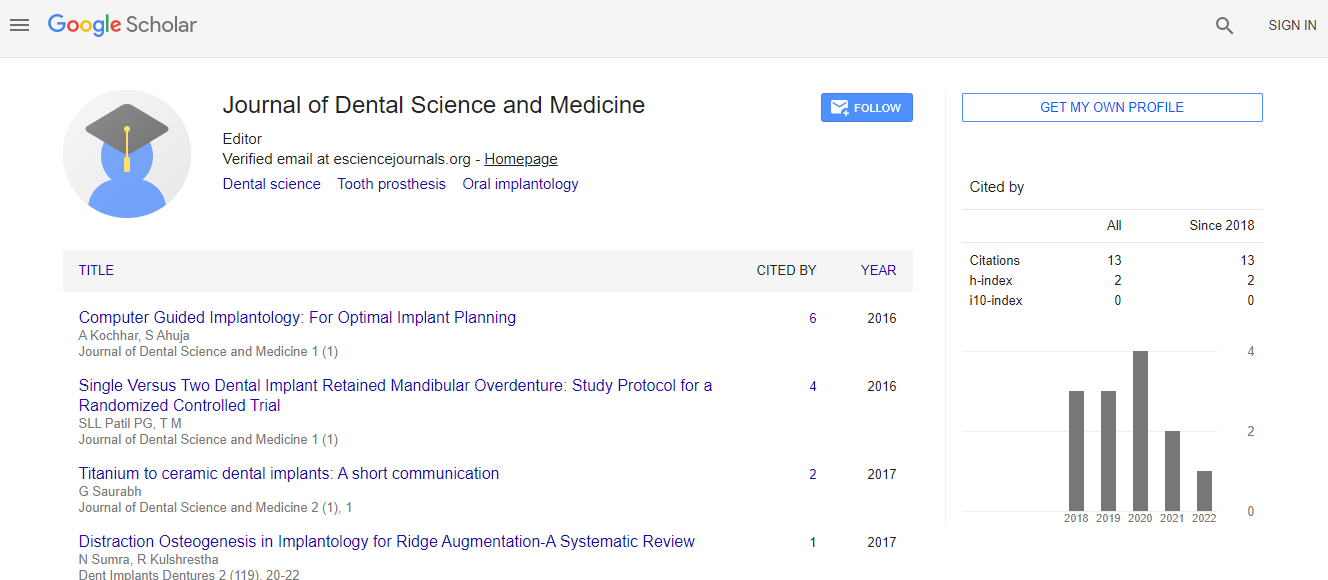Our Group organises 3000+ Global Conferenceseries Events every year across USA, Europe & Asia with support from 1000 more scientific Societies and Publishes 700+ Open Access Journals which contains over 50000 eminent personalities, reputed scientists as editorial board members.
Open Access Journals gaining more Readers and Citations
700 Journals and 15,000,000 Readers Each Journal is getting 25,000+ Readers
Google Scholar citation report
Citations : 13
Journal of Dental Science and Medicine received 13 citations as per Google Scholar report
Indexed In
- RefSeek
- Hamdard University
- EBSCO A-Z
- ICMJE
Useful Links
Recommended Journals
Related Subjects
Share This Page
Plant-based Compounds for Maintenance of Oral Biofilms
7th International Conference on Prosthodontics & Orthodontics
Fathilah Abdul Razak
Faculty of Dentistry, University of Malaya,50603 Kuala Lumpur, Malaysia
ScientificTracks Abstracts: Dental Science and Medicine
Abstract
Oral biofilm or dental plaque is a localised concentration of bacteria embedded in a soft matrix that covers the tooth surface. At the early phase of formation, it comprised of salivary components which serves important role as binding receptors for pioneer oral bacteria. Assisted by electrostatic and hydrophobic interactions between these microbes and saliva-coated tooth surface, the adhering cells grow, generates energy through metabolism and multiply, eventually forming ecosystem of the oral cavity. Predominancy of microbes within this ecosystem has been shown to be affected in response to diet, antibiotic treatment and also to aging, as surfaces of teeth for bacterial adherence gradually reduces. It is shown that the candidal species increasingly predominate in oral cavity of the elderly adults. Common oral diseases associated with biofilm includes dental caries and periodontal diseases. Effective biofilm control strategies forms the basic principle in the prevention of these diseases. Many chemical-based dentifrices and mouth rinses are widely used for the maintenance of oral health. However, though effective, there has been concern on their side effects. We have shown that compounds from several plants are effective in reducing the formation of oral biofilm. Many exhibited bacteriostatic effect on biofilm microbes rather than bactericidal like chlorhexidine. The targets of these compounds were suggested more towards inhibiting bacterial adhesion and suppression of cell growth activities at various phases of biofilm formation. In other words, by preventing or limiting bacterial adhesion and their subsequent growth on the tooth surface, the severity of biofilm-associated diseases can be minimised.Biography
Dr Fathilah was awarded PhD by the University of Malaya in 2005 in the area of Oral Biology. Her research passion revolves around the oral ecosystem and interactions between various components of the oral environment. Currently she is the Head of the Oral & Craniofacial Sciences Department that focuses on bridging knowledge of basic medical sciences with the dental curriculum. She has published numerous articles and is actively involved in reviewing scientific manuscripts for various journal publications.

 Spanish
Spanish  Chinese
Chinese  Russian
Russian  German
German  French
French  Japanese
Japanese  Portuguese
Portuguese  Hindi
Hindi 